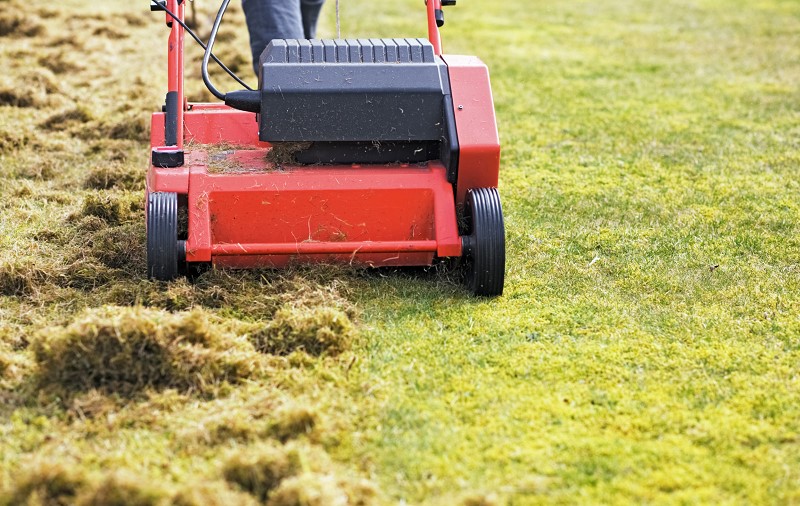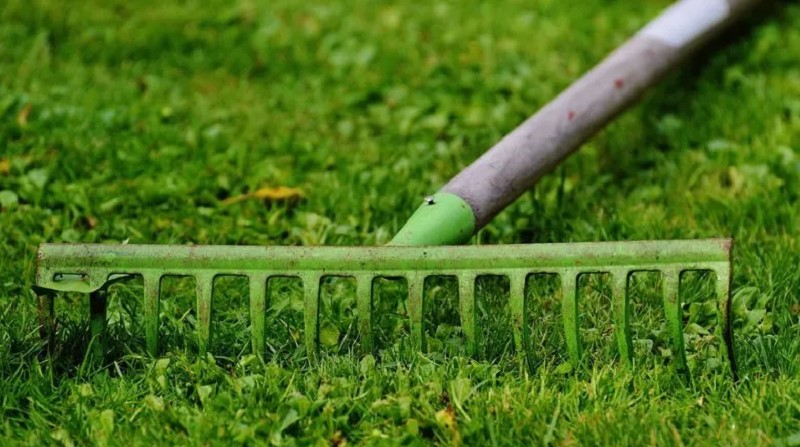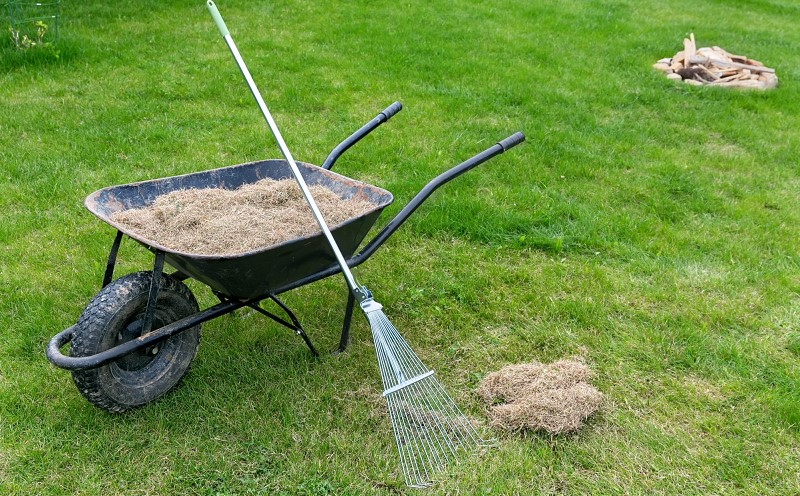Quite often, straw can be seen on the lawn. This is dry vegetation, which can bring both benefit and harm. Therefore, many are trying to understand what are the pros and cons of dethatching lawn. More about the pros and cons of dethatching lawn you can find in this article.

Main advantages
There are many pros and cons of dethatching a lawn that must be considered before starting a yard cleanup.
It is advisable to study them to preserve the beauty of the site, as well as to save time.
After all, the cleaning process is very laborious.
Guaranteed sufficient nutrient components
The straw is dead grass or other vegetation. It may consist of leaves, root systems, and grass.
Often such elements are not required for the full development of the lawn. Therefore, you must remove the thatch layer on time.
Some gardeners believe that they can use the thatch buildup as natural compost material. However, it is important to understand that these plants decompose.
Over time, they deplete the nutrients that are found in the soil where the lawn grows.
If the thatch buildup is removed, the soil surface opens up for the penetration of nutrients. They are very important for the full and proper development of the lawn.
Grass needs access to nutrients. After all, this guarantees its proper growth and development.

Penetration of water and air into the soil
For proper lawn growth, enough water and air must penetrate inside. You can water the grass blades from irrigation or precipitation. Most gardeners prefer to lay a natural lawn in the yard, consisting of live grass.
For it to survive and develop, it is necessary to provide it with enough water and air. If straw remains on the surface, it blocks the passage of all important components, so it is very difficult for plants to grow.
If the thatch buildup is more than one inch thick, grass prosperity is reduced to a minimum.
If you remove the excessive thatch regularly and on time, the lawn grows and retains its green color.
Proper care ensures the beauty of the lawn thatch. Therefore, you can easily walk around the yard with your children and admire the beauty of the site.

Grass blades control
It is important to ventilate the lawn. This allows you to deal with excess straw in the future.
If you often rake too much thatch, you risk damaging the tool, as well as living plants that are growing well.
It is advisable to rake the straw periodically. Let this process take longer. This is the only way to keep your lawn healthy.
A fairly large of gardeners are wondering not only the pros and cons of dethatching lawn but also, is dethatching necessary.
Delamination shows up as thinning and discoloration of areas throughout the yard.
At the same time, they can be located on different sides of the yard, which negatively affects their external attractiveness.
To return the grass blades to their original good condition, it is recommended to remove the straw. However, try to carry out the procedure carefully so that healthy grass is not damaged.

Yard attractiveness
As you know, the main signs of a healthy lawn are green grass with thick turf, where there are no bare spots.
If you need to improve the exterior of your yard, it is recommended that you pay special attention to the removal of the thatch layer.
Disease prevention
As you know, lawn grass is no different from other types of plants. It is also characterized by infection with various diseases and pests.
Regular removal of the grass clippings on the lawn helps to eliminate this possibility.
Open bushes are better able to resist infections caused by pests or other factors. All your actions should be aimed at preserving the immune system of lawn grass.

Main cons of dethatching lawn
You must understand that there are cons to dethatching lawn, especially for the uneven lawn. Often this is due to the time-consuming process, as well as its frequency.
If there is a thick thatch layer on the lawn, you may have to restore order several times a year.
Providing drainage on the site is not always achievable. It all depends on the type of soil. The main disadvantages are described in more detail below.

Cons of dethatching lawn: the high cost of work
Many people find the straw harvesting process repulsive due to its high cost. If the yard is large, you have to spend $100 to $1000.
It is impossible to say the exact cost because everything depends on the amount of work, as well as the need for the aeration process.
If the yard is small, or if thatch layer occurs frequently, the initial investment may not pay off.
If you want to constantly maintain the beauty of the site, you better worry about buying a quality lawn mower. You do not have to contact special companies and spend huge amounts of money.

Thatch layer can cause the soil balance damage
If regularly, and without experience, remove the straw, there is a high probability of disturbing the correct level of acid-base balance, as well as nitrogen.
Because of this, the condition of the soil deteriorates, and of which the lawn suffers.
To avoid this problem, you need to constantly distribute a sufficient amount of compost or other organic matter around the site. It is best to do this immediately after the dead grass is removed from the area.

The complexity of the process
It is quite difficult to clean the straws all the time physically. You need to use the power rake to remove thatch for several hours a day.
If the weather permits, nothing else. If the air temperature reaches 90 °F, work is difficult.
Cons of dethatching lawn: the destruction of beneficial bacteria
Once the straw is removed, the soil is exposed. That is why beneficial bacteria dry out and die under direct sunlight. Because of this, the number of harmful bacteria that adversely affect the condition of the lawn increase.
To avoid such unpleasant consequences, you need to mow the lawn in the fall. It is in the conditions of this time of year that it is better to do work in the yard.
Blade damage
If you prefer to rake straw manually rather than mechanically, try to work carefully. If the movements are too energetic, and with great effort, you risk damaging the root system of the grass, as well as its stems.

How to remove the too much thatch buildup from the lawn: a few tips
Before you go shopping with a special machine, you should first study the principle of its operation.
It is possible that after such analytics you no longer think about buying an instrument. Easier to handle with manual cleaning. This give less stress on the back, as well as financial condition.
If you still decide to buy your tool, first you need to prepare the yard for work. Prepare in advance the materials that are required for work.
This applies to gloves, garbage bags, etc. You also need to remove adapters and extension cords from the house to connect the device.
On the site, you need to mark the structures and utilities that are underground. This eliminates the possibility of damage to them.
Lawns may have pollution, where a lot of bacteria accumulate. They can be left by animals, or by other factors.
If you wash them off, you can wash out even bacteria that are good for your lawn. It is better to clean the lawn in the fall because most bacteria die when it gets colder.
If you’re using a power rake or a rental car, start working from the farthest corner of the site. Choose areas with less wear. If there is no experience in such work, it is better to move slowly. Otherwise, you risk damaging a healthy lawn.
If possible, it is better to hire a knowledgeable person who quickly and efficiently does all the work.
Yes, the cost of the services of such masters is quite high. However, thanks to such investments, you can spend a summer day with friends and family, and not with garden tools.
Try to study the market for such services in your area in advance. You are sure that the work is safe and efficient, and in the future, the lawn remain healthy.

FAQ
When it comes to removing excessive thatch from your lawn, there are a lot of questions. Detailed answers you can read below.
- Is dethatching necessary? Over time, there is a new accumulation of straw, so it is not necessary to remove it annually. Some gardeners advise doing such work at intervals of 5 years, or as needed.
- Is it better to dethatch or aerate? Before proceeding with aeration, the straw must be removed. This allows air, water, and nutrients to better penetrate the soil and saturate the grass.
- What happens if you don’t dethatch? As already mentioned, if the layer of straw is more than 1 inch, this is not an advantage, but a barrier. This blocks water and fertilizer. The fact that the roots get stuck in the straw is not excluded.Therefore, they are more susceptible to drought and stress. Often, water accumulates in the straw, which remains after watering. The root system suffocates because it does not have enough air.
- What is the best time to dethatch a lawn? It is recommended to remove the straw from the lawn when it is actively growing. It must be good soil moisture. If you live in a cool region, work with cool season grasses in the spring or early fall.Growers from warm regions can harvest in May or April when the second cut is completed. During such periods, the grass is characterized by active growth.
Conclusion
As you can see, there are pros and cons of dethatching lawn. However, cleaning should be done at least once every few years. After all, this way you can update the site, and make it attractive. All work must be carried out correctly, so it is better to hire a specialist.
- Why Are There Still No Tomatoes in My Tomato Plants? Let’s Fix the Issue! - July 13, 2023
- Water Propagation White Stuff on Roots: Everything You Should Know! - July 11, 2023
- String of Dolphins Drying Up: Solved! - July 11, 2023


